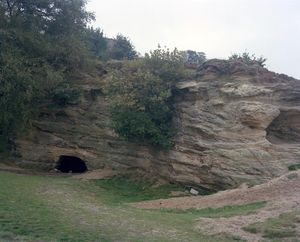Central England area - Cheshire-Shropshire
This area lies in the northwest of the region, covering the area from Chester to Congleton in the north, and down to Wem in the south. In geological terms, this area corresponds to the Cheshire Basin, an area of sedimentary rocks dipping inwards towards the centre. As a result, the central part where the rocks are mainly soft is relatively flat but to the west, south and southeast there are a prominent ridges formed of sandstone. The eastern margin of the Cheshire Basin is defined by a major geological fault, with older rocks generally occurring at the surface across the fault in the central part of the region.
Sedimentary Bedrock

The youngest sedimentary bedrock in the area occurs in the centre of the basin, between Wem and Audlem, and comprises around 600 m of Jurassic marine grey mudstones with some thin limestones common at the base and are seldom exposed at the surface. Beneath these rocks and at or near surface across most of the rest of this area the sedimentary bedrock comprises red mudstones (Mercia Mudstone), up to 2000 m thick. These mudstones formed 240 to 200 million years ago in a desert by the accumulation of wind-blown dust, with some deposition in temporary lakes. Thin sandstone layers occur especially near the bottom of the mudstones. The desert was very low-lying and, at times, the sea encroached into this area. Periodic evaporation of the sea water then led to the precipitation of layers of rock salt up to 50 m thick. These have been extensively mined in Cheshire and form the main source of salt for the country as a whole; the mining has led to extensive subsidence over much of this area. The old salt mines provide a very dry environment and are now used for storing a variety of materials, including low-level radioactive waste at Winsford, gas at Sandbach and also old documents.
Beneath the thick red mudstones lies a prominent red sandstone layer, the Sherwood Sandstone, and this outcrops at the surfaces forming ridges, especially around the western (Plate P222787) and southern margins of the basin. It is 600 to 700 m thick, about 250 million years old, and consists of sands, muds and pebble layers deposited by a major river that flowed northwards across England. The thick sandstones are porous and are used to provide large quantities of drinking water. Rocks which provide water in this way are referred to as aquifers, and the Sherwood Sandstone is a very important aquifer in Central England. Water is abstracted both from areas where it occurs at surface and where it is covered by younger rocks, down to a maximum depth of around 400 m. The water becomes more saline with depth and in the central part of the area it is generally not abstracted.
The Sherwood Sandstone is underlain by a succession of mainly red and grey mudstones and sandstones deposited from around 300 million years ago.